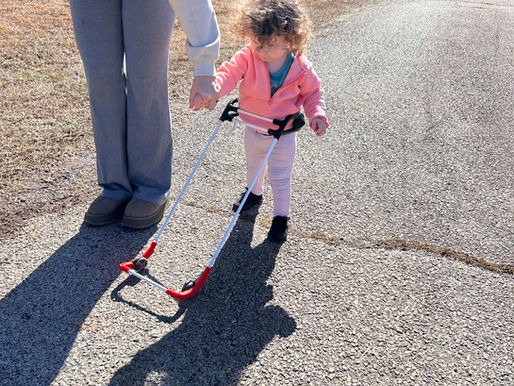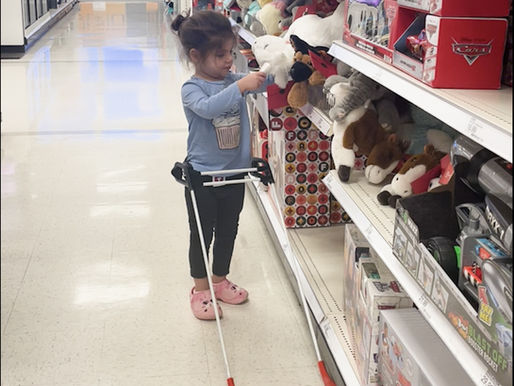top of page
Blog


Supporting Mobility with Pediatric Belt Cane
A Pediatric Belt Cane is designed specifically for children who need assistance with mobility. Unlike traditional canes, which can be cumbersome or difficult for small hands to manage, the Pediatric Belt Cane offers a hands-free solution. It wraps securely around the child’s waist, allowing the cane frame to be attached and easily accessible without the child having to hold it constantly.

Grace Ambrose-Zaken
3 days ago


How a Pediatric Mobility Cane Enhances Independence and Safety
Mobility challenges can feel daunting, but with the right tools and support, children can thrive. The Pediatric Belt Cane is more than a device - it’s a key to unlocking a world of possibilities. So, why wait? Explore options, seek professional advice, and watch your child take confident strides toward independence.

Grace Ambrose-Zaken
7 days ago


Empowering Mobility with Pediatric Mobility Aids: A Guide to Belt Canes and More
When a child faces challenges with vision, mobility becomes a crucial part of their independence and confidence. Pediatric mobility aids are designed to support children in navigating their world safely and effectively. These tools are not just devices; they are bridges to freedom, exploration, and self-reliance. Today, I want to share insights about one such essential aid and the broader landscape of pediatric mobility aids that empower young lives.

Grace Ambrose-Zaken
Dec 11


Thankful for Pediatric Belt Canes Supporting Early Mobility
Mobility tools for children with visual impairments or blindness are tailored to their unique needs. Unlike adult devices, pediatric tools consider size, weight, and the developmental stage of the child. The Pediatric Belt Cane is a perfect example. It’s lightweight, easy to handle, and designed for children.

Grace Ambrose-Zaken
Nov 28


The Benefits of Pediatric Belt Canes
Safety is paramount when it comes to overseeing the education and play of young children. The Pediatric Belt Cane plays a crucial role in reducing risks associated with immature cane handling. When a cane is dropped or misplaced, the child may be vulnerable to tripping or losing orientation. The belt eliminates these hazards by keeping the cane firmly attached.

Grace Ambrose-Zaken
Nov 24


Your Blind Child Isn’t being “Bad” — The Cane Is Too Difficult to Swing Each Step
If your blind child resists using their cane, it’s not defiance — it’s design. Many young children struggle to swing a traditional long cane safely or effectively. Learn the five signs your blind child’s cane or mobility device isn’t right and discover how the Pediatric Belt Cane can help them walk confidently, safely, and independently.

Grace Ambrose-Zaken
Nov 4


Enhancing Mobility for Visually Impaired Children with Belt Canes
Mobility tools for vision impaired children are designed to help them detect obstacles, understand their environment, and move safely. These tools range from traditional long canes to more innovative devices like the belt cane. Each tool has its unique benefits and applications.

Grace Ambrose-Zaken
Nov 3


Unlocking the Mystery: How White Canes Work
When vision can’t guide a child, touch can. The white cane extends that touch, offering safety, awareness, and freedom of movement. Discover how the Belt Cane adapts this essential mobility tool for the youngest learners.

Grace Ambrose-Zaken
Oct 17


🌟 White Cane Day Has New Meaning for the Youngest Explorers
White Cane Day has new meaning for children who are blind from birth. With the Pediatric Belt Cane and Rectangular AMD, even toddlers can now join the celebration — walking safely and independently using touch for balance, protection, and exploration.

Grace Ambrose-Zaken
Oct 13


🛝 Accessible Play Starts Here: The Pediatric Belt Cane Advantage
Playgrounds should be places of freedom, not frustration — especially for blind children. The Pediatric Belt Cane gives young blind kids the ability to explore, climb, swing, and slide with confidence by providing real-time tactile feedback about their environment. It’s not just a mobility tool — it’s the key to truly inclusive, independent play.

Grace Ambrose-Zaken
Oct 6


🧭 It’s Not Orientation, It’s Mobility: A Thought Experiment for Parents of Blind Children
Most people assume blind children don’t know where they are — but the real challenge isn’t orientation, it’s mobility. In this eye-opening thought experiment, you’ll discover how blind kids can confidently know their space, yet still need tools like the white cane to move safely. Try it yourself: close your eyes, navigate your home, and gain a deeper understanding of what your child truly experiences.

Grace Ambrose-Zaken
Sep 29


Empowering Independence: Chores for Children with Visual Impairments
Now that your blind child is moving confidently with the Pediatric Belt Cane, it’s the perfect time to start building independence at home. Learn how to teach age-appropriate chores through direct instruction, tactile routines, and daily practice—empowering your child to develop essential life skills one step at a time.

Grace Ambrose-Zaken
Sep 22


🧭 Navigating with Confidence: The Role of Pediatric Belt Canes in Empowering Children with Visual Impairments
Children begin learning to navigate their world from the moment they start moving. For children with blindness or mobility-related visual impairments, this process can be more complex — but no less vital.
Traditional mobility tools like long canes often aren’t introduced until school age, which can delay critical stages of physical and cognitive development. The Pediatric Belt Cane, however, provides the tactile input needed to safely begin independent movement as early as 1

Grace Ambrose-Zaken
Sep 17


Why Does a Blind Child Need a White Cane Arc for Safety, and what is it?
The white cane arc is an essential tool for anyone with a mobility visual impairment or blindness (MVI/B). Yet, children with an MVI/B struggle to even hold the long cane much less sweep it back and forth with each step. Children can push a static white cane arc in front of them. The static white cane arc is when it is built into the device.

Grace Ambrose-Zaken
Sep 9


Who Prescribes the White Cane? Rethinking Early Mobility for Blind Toddlers
When a child is born blind, parents look to pediatric ophthalmologists for answers—but who provides the tools for safe, independent walking? With new research showing the benefits of the Pediatric Belt Cane, it’s time to rethink early mobility and who should be prescribing it.

Grace Ambrose-Zaken
Aug 25


Blindness is a Sensory Disability, not an Intellectual Disability
Imagine a playground at recess: children darting, laughter ringing in spontaneous choreography. Now, enter a blind child who is wearing a...

Grace Ambrose-Zaken
Aug 19


Empowering Children with Pediatric Belt Canes
When a child faces challenges with mobility or vision, the right tools can make all the difference. Pediatric walking aids are designed...

Grace Ambrose-Zaken
Aug 16


Innovative Belt Canes for Kids with a Visual Impairment
Navigating the world can be challenging for visually impaired children. Traditional mobility aids like long canes are effective but can sometimes be cumbersome for young users. Enter the innovative belt cane for kids - a compact, user-friendly solution designed to empower children with visual impairments to explore their surroundings confidently and safely.

Grace Ambrose-Zaken
Aug 6


Top Mobility Solutions for Children with Visual and Motor Impairments
When it comes to helping children with mobility challenges due to visual and motor impairments, finding the right tools can make all the difference.

Grace Ambrose-Zaken
Aug 5


Empowering Pediatric Mobility with Belt Canes
One innovative tool that has emerged to address mobility challenges is the Pediatric Belt Cane. This assistive device empowers children, helping them gain confidence and navigate their environment with ease.

Grace Ambrose-Zaken
Jul 14
bottom of page




